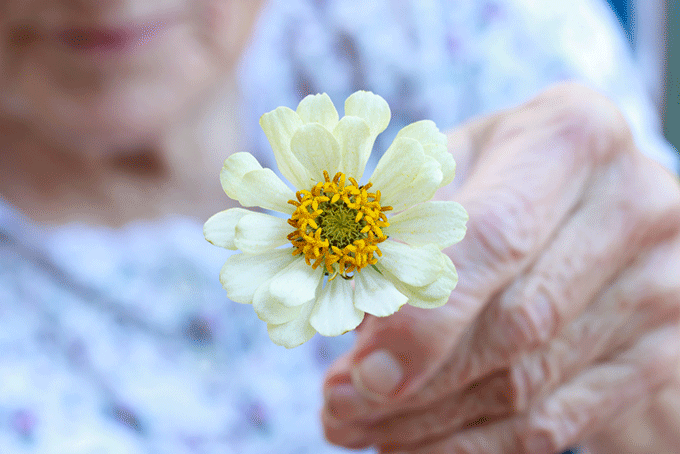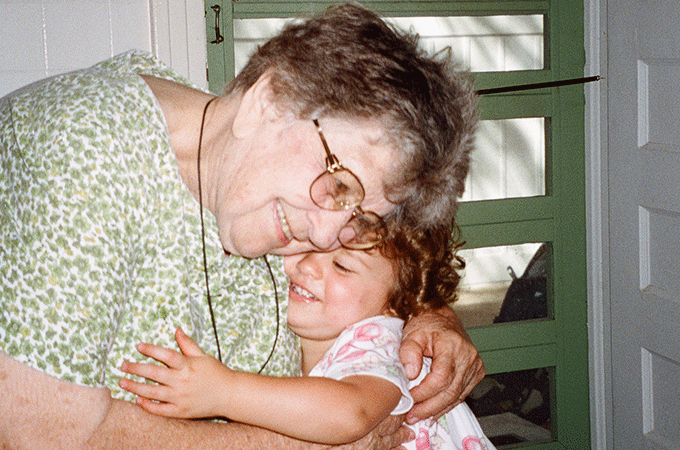When we were in our twenties, my husband and I moved from the D.C. area to Austin, Texas, at a time when Austin rents were still comparable to a mortgage on a small home (aaah, the ’90s!). So we purchased a two-bedroom house in Rosedale, a cozy neighborhood settled in the 1940s near the University of Texas where the mostly tiny houses lacked dishwashers, garages or sidewalks, but compensated with mature Live Oak trees and other natural charm. My grandparents from Dallas fell in love with our place on their first visit, because it reminded them so much of their “starter home.”
We were welcomed to the neighborhood by our next-door neighbor, Mrs. Gest. Frieda Gest was one of several seniors still living on 40th Street, which was a dirt road when her first husband built their home. At 91 and widowed twice, she would walk with her cane to the chain link fence that separated our yards to chat, sometimes offering us a cutting from her yard or something she had baked. Whenever I took her an extra serving of whatever we had made for dinner, she always returned the container with homemade vanilla wafers in it. (I later learned that she kept a freezer full of cookies so that she always had something to offer.) These exchanges were always occasion for conversation that would often end with her genial “Now don’t rush off” and my pangs of guilt, even after an hour-long visit.
On my 29th birthday, as I arrived home from work, I noticed a sizable coleus planted in the flowerbed by our front door. It baffled me for days, with my best guess being that my take-charge aunt, who often breezed through town, must have left her mark. The next time I saw Mrs. Gest sitting on her front porch, she shouted to me, “How do you like your coleus?” Mrs. Gest didn’t believe in spending good money plants that could be acquired through neighbors’ yards or through digging up “volunteers” from alongside the road.
She spent considerable time maintaining her tidy house (just a closet or room each day), making her own housedresses, and handcrafting gifts or items for her church bazaar. She held a garage sale…in her 90s! She sewed baby bibs from scrap material, crocheted leftover yarn into a blanket and, later, a doll blanket for my daughter. Mrs. Gest was always giving, always something of herself, and nothing I can remember from a store.
In 2014, this kind of hands-on lifestyle and “sharing economy” is something our generation now craves. How else to explain the rise of “DIY,” Etsy.com, edible and community gardens, farmers markets, slow food, bicycling, chicken coops, backyard composting, thrift shops, plant swaps, clothing swaps, food swaps and cooperatives?
I firmly believe this trend spawns, in part, from our awareness that unbridled consumerism, production and waste have threatened our environment. And maybe these activities help us counter the isolation that sets in when we succumb to our screens. It’s the swinging pendulum that I couldn’t begin to theorize for Mrs. Gest if she were still alive. But here are just a few things she taught me—things that a lot of us can now appreciate:
“Waste not, want not.” This includes food! Share it, preserve it, freeze it, compost it—just don’t send it to the landfill. As for household items and clothing, if you don’t have a use for it, find someone who might. If I can’t think of someone who could use an item, my favorite resource for re-homing it is either donating it to a non-profit or a thrift store, or posting it to the local Yahoo group created by my central Austin neighbors to buy/sell/give away. Other online options are, of course, Craigslist, and possibly a local “Nextdoor” online community or local “Freecycle” Yahoo group. If you’re willing to ship an item, there are plenty more online options, like yerdle, eBay and PaperBackSwap.
If you really need it, can you borrow it or get it used? Is there someone who could share the cost with you? Remember your local library for books, music and DVDs. Remember your neighbors for tools. A neighbor and I purchased a food dehydrator together, because it costs a lot, takes up space, and isn’t something we use every day.
Find joy in slower living. Our great grandmothers didn’t have a choice BUT to live slowly and, as a result, relatively sustainably. Everything took more time—from producing food in their gardens, to hanging up the laundry on a clothesline, to upcycling those fabric scraps into quilts. Our generation has so many conveniences that it can be hard to choose which one we should re-think and which new habit we’ll adopt. But if you just DO ONE THING that you might enjoy while living lighter on the planet, your more sustainable lifestyle is more likely to stick and bring you the joy that comes from living your values.
What are some of the ways you and your family embrace the simple life? Share them with us here!
Amy Chamberlain is governmental affairs consultant in Austin, Texas, who is passionate about our environment and her daughters’ futures.










2014/05/13 at 7:16 am
I’ll have to think on that but loved your article. I have a lot of older friends like this and they really do teach me to slow the hell down and enjoy life more. thanks for sharing!